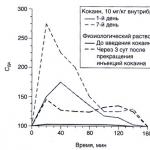The problem of soil shedding along the shoreline of reservoirs is not uncommon, and strengthening the banks of the pond with your own hands is an issue that worries many owners country houses, mansions and dachas. Problems with soil subsidence are faced by those who live near water, who have a summer house next to a pond, or suburban area. Those who have created an artificial reservoir on their territory are also aware of this problem.
An artificial pond is not only decorative decoration garden, but also brings freshness to the surrounding atmosphere.
There are many options for strengthening the banks of a reservoir. Therefore, before you begin to strengthen the shoreline of a pond, lake or stream, it is necessary to evaluate a number of factors, namely:
- soil characteristics;
- features of the banks: slope angle and height;
- how the soil crumbles (from the surface, over the entire area of the coast, only the part that is under water, etc.);
- how long ago was the artificial pond built;
- location of problem areas;
- location and functional purpose of the territory in the area of which it is necessary to strengthen the bank;
- peculiarities climatic conditions: amount of precipitation, changes temperature regime etc.
Having assessed all of the above factors, you can decide which strengthening of the shoreline of reservoirs should be chosen. Let's take a closer look at the pros and cons various methods strengthening
Popular types of fortifications

The reinforcing lattice is installed along the coastline and filled with rubble, tumbled or other types of stones.
Piles are used to strengthen steep slopes. Apply hardware, reinforced concrete, wood of certain species (for example, larch), as well as plastic products. This reinforcement structure is similar to log wall, however, assembling it with your own hands is quite difficult, since the piles need to be driven in.
Anti-erosion mesh is a soft and flexible material. An anti-erosion mesh can be called a spider web, which is laid out on the surface of the soil and covered with earth. Plants, and more specifically their roots, bind the mesh to the soil, resulting in the formation of a holistic protective layer. A variety of this reinforcing material is coconut mat - a very common material for strengthening the banks of a pond in the country.
To construct an artificial wall, a reinforcing lattice or mesh is used. It is installed along the coastline and filled with rubble, tumbled or other types of stones. Such a strengthening is similar to formwork, one of the sides of which is the shoreline of a pond or lake.
Return to contents
Strengthening the coastline with geogrid
Strengthening the bank using a geogrid is quite simple. This technology provides for a kind of reinforcement of crumbling soil. On top, as a rule, the geogrid is covered with marble chips, pebbles or other hard materials. This strengthening method is only suitable for gentle slopes.

Geogrid is a design of links made of polymers that are resistant to environmental influences.
To strengthen you need to purchase:
- crushed stone and frost-resistant concrete;
- non-woven geotextiles;
- anchor;
- shovel, scraper and pneumatic stapler.
Operating procedure:
- Leveling the surface of the coastal slope.
- Creating the shape of the slope; on gentler slopes the reinforcing structure will be more durable.
- Laying geogrid.
- Stretching and strengthening the material in a checkerboard pattern using anchors.
- Fixation of modules with a pneumatic stapler.
- Filling geotextile cells with additives in the form of concrete or soil manually.
And if dreams come true, and a beautiful small pond grows before your eyes, it is not the thoughts of Turgenev’s heroes that begin to worry you. Soil erosion - here permanent source worries. This phenomenon tends to destroy the skillfully made shore, destroying such noble undertakings.
During this natural process, the reservoir begins to lose its perfect shape, a significant part of the bottom silts up, and the graceful pond turns into a swamp. To solve this issue there is a universal construction method– strengthening the coastline.
Why do you need to strengthen the bank?
Water in nature is not capable of creation. Rapid flows of water wear away even solid rocks, and heavy rains cause mudflows. In this regard, although calm water looks much safer, its destructive effect cannot be denied.
Only rocky natural shores can withstand water. But in fairness, we note that rocky formations are extremely rare in summer cottages. To maintain its original form and appearance pond, extend it life cycle, it is necessary to turn to technology for strengthening the shore of a reservoir.
To the most effective means protection of weak soil from erosion is usually attributed to technical procedures using artificial and natural materials. You can determine the appropriateness of using a particular method and material by reading the recommendations of specialists.
How to properly strengthen the shore of a reservoir?
Literate integrated approach to the design of the shore of a reservoir will allow you to obtain an aesthetic appearance, at the same time reliably strengthening the stability of the coastline. This is the only way to prevent the threat of erosion of coastal soil.
At the same time, it is quite easy to find information on the choice of materials, the method of installing waterproofing, edging and other construction operations in the abyss of the Internet. However, clear recommendations regarding shoreline strengthening are not provided online. Let's fill the gap.
Pond with concrete base: what materials to choose?

Due to the fact that the coastline is ideally visible from all points of the site, materials for strengthening and decoration must certainly fit into the overall landscape style. The most common materials for decoration are:
- marble;
- pebbles;
- rocks;
- paving slabs;
- wood hard rocks;
- granite.
If the base of the reservoir is concreted, the best option would be to choose marble chips, glass mosaics or ceramic chips. Finishing materials can be effectively laid on cement-sand mortar. At the same time, builders advise to embed shards of glass and ceramics into the concrete, otherwise the sharp edges can then injure.
The main condition for a successful set of works is considered to be reliable installation each element, be it a decorative boulder or a reinforcing part in a specific place. So, fastening brick blocks, paving slabs or natural stones carried out using cement mortar using moisture-resistant additives.
Another important point: since plant flora is used when decorating the coastal line, it is recommended to provide areas of soil for planting. Moisture-loving plants and trees go well with an artificial pond.
Pond with film base

If the bottom of the reservoir is isolated by waterproofing film, a special coastline can be used decorative film with a gravel coating. Imitation rock will allow you to hide artificial origin material. The film is installed on top of the main waterproofing layer. The edges of the material are attached adhesive composition to the base. Moreover, it is recommended to choose a special glue for water work. In this case, the rocky edge finishing material will speak for coastline.
Crowning the installation process decorative elements. Along the edge artificial pond install stones various shapes and sizes. At the same time, designers advise creating a unique landscape line reminiscent of a natural picture. This is the most affordable and technologically simplest method of constructing a spectacular decor for a pond with your own hands.
Strengthening the bank with coconut mats
Coconut mats are used in the process of strengthening the shoreline of a reservoir with a film base and steep edges. This material has a characteristic dark color, which hides the unsightly appearance of the film when the water level drops. Due to their color similarity to natural soil, the mats camouflage the building parts of an artificial structure. Moreover, moisture-loving flora grows well through the structure of the material. Plants and bushes ideally decorate the coastal line, and the roots of vegetation act as additional strengthening of the soil.

The technological side of laying coconut mats is not complicated. An ordinary average person will be able to understand the intricacies of installation. So, how to strengthen the shore of a reservoir using this material:
- Laying starts from the coastal part. In this case, the building material is not stretched.
- The lower part is placed half a meter down along the edge of the reservoir.
- The upper part is attached to land using reinforcement.
- To attach the mat to the waterproofing PVC film, water-repellent mounting adhesive is used.
- The joint of the canvases is fastened using an overlap technology of 20 cm. Please note that the direction of the overlap must be located on the side inaccessible for viewing.
- The mat on top is covered with plant substrate.
- The immersed mat is covered with fine-grained gravel and sand.
If it is not possible to decorate the coastline with artificial or natural stone formations, vegetation comes to the rescue. Flora in the form of decoration bordering the pond looks elegant and as natural as possible. Landscape designers use this technique when creating a landscape style.
Advantages of coconut mats
Among the undoubted advantages of coconut mats it is worth noting:
- UV resistance;
- resistance to substances formed as a result of the decomposition of substances of organic origin;
- environmental friendliness;
- ease of installation (you can strengthen the coastline yourself);
- practicality and efficiency (high-quality protection against washing away is provided for a long time);
- availability of material;
- a unique fibrous structure that allows plants to grow through it (they act as additional reinforcement due to the root system).
The mats effectively camouflage the waterproofing layer and act as a habitat for the rhizomes of some plants in the coastal zone.
Of course, you don’t have to use mats for strengthening. Other means will do for this purpose, but the edges of the waterproofing will be disguised as a lawn to a depth of about 10 cm. When the water level inevitably drops, the unsightly film will reveal itself to the world. In addition, a puddle will regularly appear in the coastal area after precipitation. If in the summer the puddles disappear quickly, then in the fall they will often disturb the owner of the pond.
Using mats will solve the whole range of possible troubles:
- will disguise the waterproofing layer;
- will preserve the integrity of the coast;
- will help prevent flooded areas on your lawn.
Other options for strengthening the shore of a reservoir

1. Anti-erosion mesh.
The material is flexible, durable and lightweight. When planting plants, the geomat creates a continuous canvas.
2. Geogrid.
Simple, but no less effective method. The cells, when filled with decorative filling, create an interesting effect.
3. Concrete, metal and plastic piles.
The method is productive on steep slopes.
4. Wood supports.
Larch for steep slopes seems to be the best option.
5. Gabions.
The method involves the construction of retaining walls in the form of boxes where stones are placed.
6. Plants.
The bank is strengthened by the root system of plants.
How to strengthen the shore of a reservoir with your own hands
Let us consider, as an example, several of the most common options for strengthening the coastline. All methods involve DIY installation.
Strengthening the shore of the pond using geogrid.
For this you will need:
- crushed stone;
- shovel;
- frost-resistant concrete;
- scraper;
- pneumatic stapler;
- anchor;
- non-woven geotextile.
- The surface of the coastal slope is leveled.
- The shape of the slope is created (the flatter the slope, the more stable the structure).
- The geogrid is laid.
- The material is tensioned and strengthened with anchors using staggered technology.
- All modules are fixed to each other using a pneumatic stapler.
- Geogrid cells are filled with concrete, soil, and other additives. Interestingly, filling must be done manually, otherwise the structure of the material can be damaged.
Strengthening the shore of the pond plants

It is difficult to strengthen with your own hands using vegetation. Plants in mandatory must have a powerful branched root system and be resistant to flooding. When strengthening river banks, this method is acceptable if the flow speed does not exceed 1 m/s and the waves do not reach 0.3 m.
Features of strengthening the bank with plants:
1. Shrub and herbaceous species of flora are planted in the above-water zone:
- black poplar;
- sea buckthorn;
- amorphous;
- marsh iris;
- manna;
- cattails.
2. Aquatic vegetation (for example, water iris) is planted in the underwater zone.
After planting, mandatory turfing is carried out.
Strengthening the shore of the pond with gabions
- First, a box is made from galvanized or metal mesh. Later it will be filled with large stones covering the parameters of the mesh cell.
- The empty box is fixed at the corners with rods.
- Attach the next one to the box and so on.
- To give additional strength, it is attached to the front side wooden frame. Such a structure does not deform over time, but becomes more reliable thanks to the soil and plants. By filling the cells, plants connect the frame to the soil.
Experts deservedly consider strengthening with gabions to be the most reliable and high-quality. Gabions fit perfectly into the landscape and have a beneficial effect on the formation of microflora in a pond for fish breeding and productive plant growth.
Conclusion
Of course, strengthening the coastline of an artificial reservoir is a complex and responsible task. The most reliable option is the installation of concrete or metal piles. However, this method is irrational for creating a compact country pond. It is not possible to install such supports on your own. The best option will be considered a gabion structure. The technology allows you to carry out a set of strengthening operations on your own, and at the same time improve the pond. The main thing is that it is necessary to carry out work to strengthen the soil at the stage of creating the reservoir itself.
The coastal soil of reservoirs is vulnerable and after some time is subject to deformation under the influence of humidity and weathering processes. Help to build a beautiful and durable shoreline of artificial and natural reservoirs environmental materials– gabions and lattices made of polymers.
Strengthening banks with the help of these materials is widely used both in the construction of areas with large natural bodies of water, and in the construction artificial reservoirs within the boundaries landscape design. The main task of strengthening the banks is to reinforce the soil layers closest to the surface to prevent erosion and weathering. The main materials used to strengthen the coastlines were beams, piles and stone, and territorial landscaping was also carried out within the coastal protection. The invention of the latest geosynthetic materials has made it possible to reinforce coastlines with the greatest effect, as well as to carry out various projects landscape design.
Characteristics of materials and technologies for coastal protection:
- Planting perennial grasses and shrubs. Promotes the foundation of the turf layer, which prevents the erosion of the banks. The most important disadvantages are the long time it takes to form the root system of shrubs and grasses, dependence on climate and soil quality;
- Floorings from coconut fibers. The purest material Suitable for use in protected areas. The disadvantages of coconut flooring include low service life, low resistance to cold and limited use (reservoirs or reservoirs with weak currents);
- Hardwood (larch, oak). Allows you to strengthen steep slopes, has a beautiful appearance and sufficient durability. The main disadvantage of wood piles is the quality of gradual destruction under the influence of ice cover, which appears in the depressions and cracks wood material during cold weather;
- Metal and concrete piles. They can even strengthen steep coastlines. The main disadvantage is heavy installation, which requires the use of special equipment, and also not very beautiful view;
- Polymer grating. Often used in road construction and for strengthening upper layers soil. The filler can be either crushed stone or soil. After the grass has sprouted, the lattice becomes invisible, which is why this material is widely used in design;
- Gabions, which are filled with crushed stone or stone. Most reliable method shore strengthening, suitable for work on steep banks. The appearance and structure of gabions are suitable for a huge number of landscape design projects.
More common the latest materials for strengthening the banks there are gabions and volumetric gratings, which combine environmental safety, fairly good appearance and high durability. The installation of such structures does not require the use of special equipment, so it can be done even in areas with complex surfaces and small areas.

Strengthening the banks with three-dimensional gratings
Volumetric gratings are a structure made of strips of polymers that are connected by welding.

The gratings are invulnerable to water and fungal organisms and tolerate well low temperatures and mechanical forces. The volumetric cells of the lattice are arranged in the form of a checker and can be filled with various bulk compositions. It is recommended to use such a grid when working with coastlines of low and moderate steepness. In case of rapid currents, crushed stone is used as a filler; in the case of standing waters and low currents, turf, pebbles and marble chips can be used. In a known way strengthening the banks with a lattice is falling asleep reinforced frame turf - after appearance perennial shrubs and the grass lattice is indistinguishable from close range, and the entire structure is strengthened by plant roots. This option is often used for landscaping coastlines, which consist of clay soil. Very often, such gratings are used to strengthen the banks of a pond with their own hands.

Grill installation:
- Preparatory operations: removal of top layers of soil, roots, stones, manual tamping;
- Assembly of the reinforced frame: installation of lattice parts, fastening anchor bolts, connecting parts using a pneumatic stapler;
- Filling with filler.
Strengthening the banks with gabions

Strengthening the river bank with your own hands can be done in another way, namely with the help of gabions. Gabions are three-dimensional cellular structures made of galvanized metal rod, which are divided into sections and filled with stones, crushed stone or pebbles. Depending on the surface of the site and the design goals, cubic gabions or gabions in the form of a Reno mattress are used.
Gabions for strengthening the coast help not only strengthen the coast, preventing the processes of weathering and erosion, but also transform the coast, creating beautiful smooth lines. If the shoreline of a reservoir is steep, the gabions adjacent to the water can be reinforced with special shields, which are made of hardwood. Unlike concrete and metal piles, gabions are not only durable, but are also gradually being included in the ecological system of reservoirs.

Installation of gabions:
- Preparatory operations: leveling the soil, manual tamping, if necessary, organizing a geotextile layer;
- Installation of gabions: new frame attached to the walls using rods and fixed to the ground with anchors;
- Filling with filler.
In areas with highly moist soil, in addition to gratings and gabions, drainage materials are used to protect the banks. The most commonly used non-woven textile is a durable cloth made from polymer fibers, which has filter properties with check valve and forms a layer of drainage holes between the soil and the reinforced frame.
There has long been a trend towards the popularity of land plots near reservoirs, both natural and artificial. Any body of water has the ability to become polluted, and the banks are characterized by destruction and degradation over time. Therefore, to obtain a safe environment, timely strengthening of the banks of the pond is required.
It is very important to monitor the proper condition of the banks when any buildings are located close to the water; crumbling and unclear boundaries can contribute to the destruction of structures. In addition to the necessity, strengthening measures contribute to obtaining a landscaped area.
Existing methods of strengthening the coastline
Long-term success is achieved by using comprehensive measures; methods of strengthening the shore of a pond are divided into:
- biological;
- technical.
The first involves the use special plants, such as planting reeds or herbaceous species. They weaken erosion processes and limit runoff surface waters. But as a disadvantage, a noticeable effect from biological techniques can be identified only over time, so the result needs to be consolidated technical means. Techniques include strengthening the coastline with gabion structures, using geogrids or special mattresses. The choice of each method is determined depending on the terrain and existing conditions.
Studying the situation is necessary to determine the measures taken

Engineering preparation of areas for pond bank development involves studying the environmental conditions:
- identification of areas with steep slopes;
- survey of the entire coastal strip;
- determination of water level data and other hydrological indicators.
A reliable coastline is characterized by stability in an unfortified state; otherwise, the steepness of the slopes will have to be changed; the required values are determined by calculations.
Applied technical base

Typically, during bank protection work, heavy equipment is used, such as tractors or bulldozers, dredgers. The latter are necessary for filling geomats and gratings with bottom sediments or other materials. But for small ponds Hand dredgers are quite suitable, they allow you to complete the entire process quickly and with effective results. Dredgers are lightweight and compact in size, which facilitates manual movement of equipment around the territory.
Basic methods suitable for designing gentle slopes
For a gently sloping shore, the following are used: geomats, gratings, nets and mattresses.

Ways to strengthen steep slopes

When the coastline is steep, the following are used: retaining walls, piles and gabions.


















